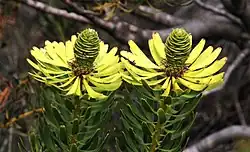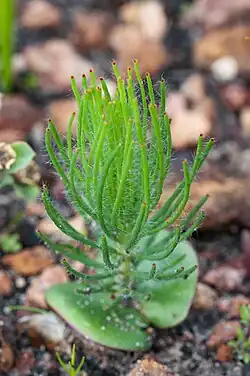Leucadendron platyspermum
| Leucadendron platyspermum | |
|---|---|

| |

| |
| L. platyspermum sprouting from seed. | |
| Scientific classification | |
| Kingdom: | Plantae |
| Clade: | Tracheophytes |
| Clade: | Angiosperms |
| Clade: | Eudicots |
| Order: | Proteales |
| Family: | Proteaceae |
| Genus: | Leucadendron |
| Species: | L. platyspermum
|
| Binomial name | |
| Leucadendron platyspermum | |
| Synonyms[2] | |
| |
Leucadendron platyspermum, commonly referred to as the plate-seed conebush, is a flower-bearing shrub belonging to the genus Leucadendron. It forms part of the fynbos biome. The plant is native to the Western Cape province in South Africa.[1]
Description
The plate-seed conebush shrub grows 1.7 m (5.6 ft) tall and flowers in December. The plant dies after a fire, but the seeds survive. The seeds are stored in a toll on the female plant and only fall to the ground after the first autumn rain after a fire. The seeds have wings and are spread by the wind. The plant is unisexual, and there are separate plants with male and female flowers, which are pollinated by the wind. The plant grows mainly in sandy and shale soil at altitudes of 0–1,350 m (0–4,429 ft).
In Afrikaans, it is known as Kraaltolbos.
References
- ^ a b Rebelo, A.G.; Mtshali, H.; Raimondo, D. (2020). "Leucadendron platyspermum". IUCN Red List of Threatened Species. 2020: e.T113170020A185548990. doi:10.2305/IUCN.UK.2020-3.RLTS.T113170020A185548990.en. Retrieved 23 September 2021.
- ^ "Leucadendron platyspermum R.Br." World Flora Online. Retrieved 2 August 2025.
External links
 Media related to Leucadendron platyspermum at Wikimedia Commons
Media related to Leucadendron platyspermum at Wikimedia Commons- Threatened Species Programme | SANBI Red List of South African Plants
- Leucadendron platyspermum (Plate-seed conebush)
- Needle-leaf Conebushes
